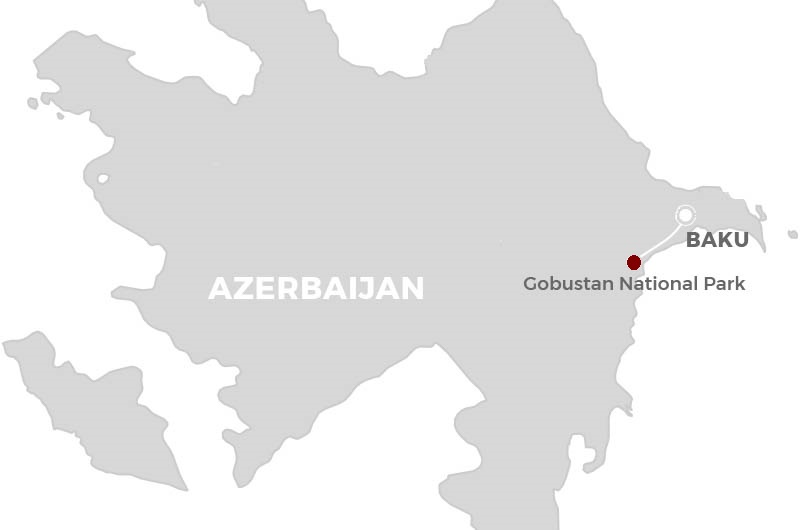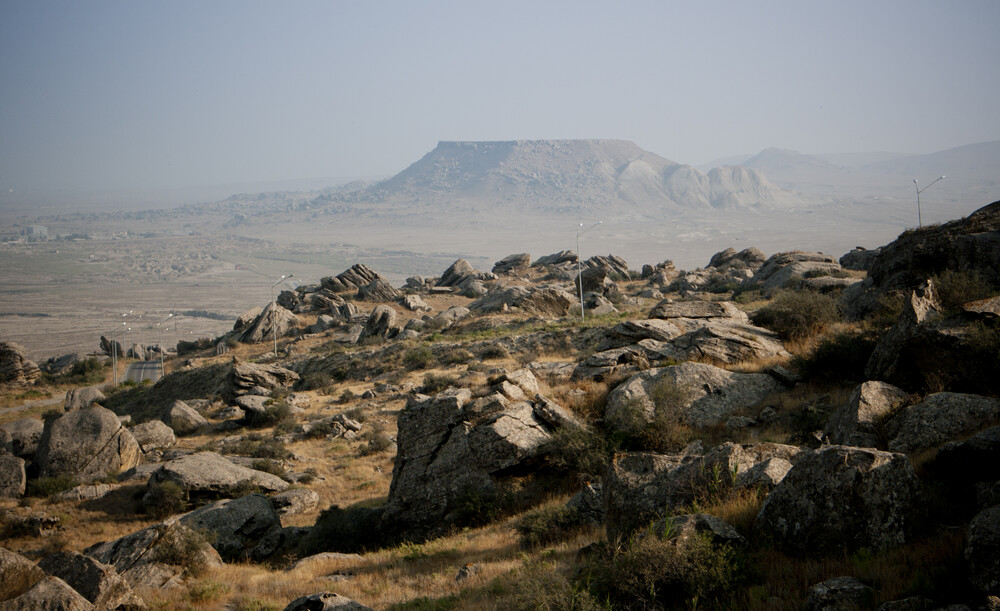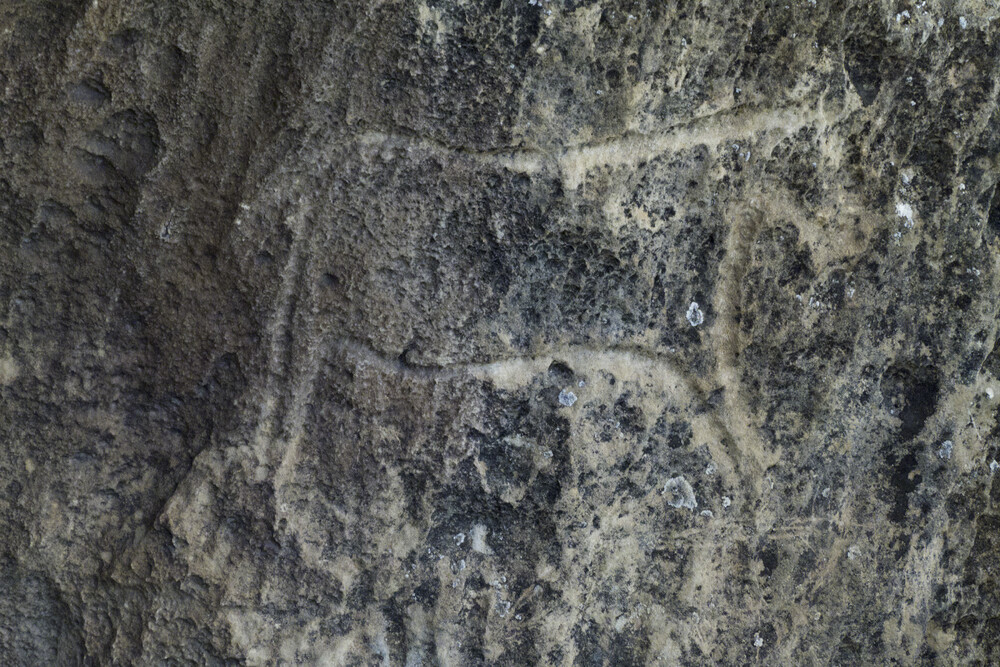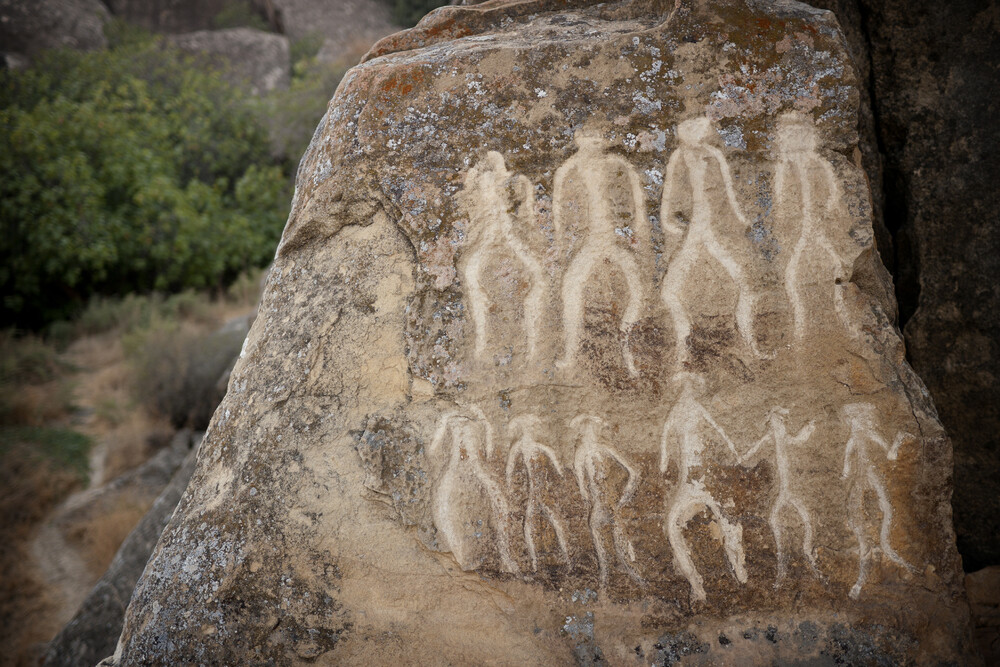ហ្គោប៊ូស្ថាន ( Gobustan) គឺជាឈ្មោះ នៃតំបន់បេតិកភណ្ឌ និងស្ថានីយបុរាណវិទ្យាមួយដែលមានទីតាំងស្ថិតនៅក្នុងខេត្ត ហ្គោប៊ូស្ថាន នៃប្រទេសអាស៊ែបៃហ្សង់ និងមានចម្ងាយប្រមាណជាង ៤០គីឡូពីរាជធានី បាគូ។ គួរបញ្ជាក់ដែលថាបាគូ គឺជាផ្នែកមួយដ៏សំខាន់ពីការដឹកជញ្ជូនទំនិញតាមរយៈកំពង់ផែពាណិជ្ជកម្មពីតំបន់អាស៊ី ទៅអឺរ៉ុប តាមសមុទ្រ Caspian ឆ្លងកាត់ប្រទេសទួគី ចូលក្នុងតំបន់អឺរ៉ុប។ ឈូងសមុទ្របាគូ គឺជាតំបន់ដ៏សំខាន់សម្រាប់ការធ្វើនាវាចរឆ្លងកាត់ទៅ សមុទ្រ Caspian និងជាពិសេស ឈូងសមុទ្រនេះសំបូរទៅដោយប្រេងកាត។ លើសពីនេះ តំបន់នៃឈូងសមុទ្របាគូ គឺជាតំបន់ដែលសំបូរទៅដោយសម្បត្តិធម្មជាតិនៅក្នុងតំបន់ Caucasus ដែលស្ថិតនៅចន្លោះនឹងសមុទ្រខ្មៅ និងសមុទ្រ Caspian។

ប្រភព៖Unesco

(ប្រភព៖Unesco)
អាស៊ែបៃហ្សង់ គឺជាប្រទេសដែលស្ថិតនៅក្នុងអឺរ៉ុបខាងកើត និងអាស៊ីខាងលិច។ តំបន់ហ្គោប៊ូស្ថាន គឺមានទំហំផ្ទៃដីជាង ៣០៩៦ហិតា ដែលជាតំបន់ជ្រលងភ្នំខ្ពស់ៗ។ ស្ថានីយបុរាណវិទ្យា ហ្គោប៊ូស្ថានគឺបែងចែកជា៦សម័យកាល ដែលគិតចាប់ពីសម័យ ណេអូលីតិច (Neolithic) រហូតដល់សម័យកណ្តាល (Middle Ages) ដែលបានបង្ហាញតាមរយៈសិល្បៈនៃគំនូរនៅលើថ្ម និងវត្ថុសិល្បៈផ្សេងៗទៀត។ គំនូរទាំងនោះ គឺគូរនៅតាមជញ្ជាំងថ្មភ្នំ តាមល្អាង ក្នុងតំបន់ ហ្គោប៊ូស្ថាន។ ១.យុគថ្មរំលីង ( VIII millennia BC) ២.ចុងយុគថ្មរំលីង( VII-IV millenina BC) ៣. សម័យកាល Eneolithic ( V-III millenina BC) ៤. យុគសំរិទ្ធ (III-II millenina BC) ៥. យុគដែក (II-I millenina BC) ៦. សម័យកណ្តាល (VIII-IX centuries and later)។
តាមរយៈរូបគំនូរទាំងនោះ បានបង្ហាញអំពីការរស់នៅរបស់មនុស្សសម័យបុរាណ និងជាភស្ថុតាងដ៏សំខាន់នៃការវិវត្តិន៍បច្ចេកទេសក្នុងប្រវត្តិសាស្រ្តរបស់មនុស្ស។ គំនូរទាំងអស់នោះ ក៏បានបង្ហាញពីការបរបាញ់សត្វ ដូចជា តោ ជ្រូក ខ្លាឃ្មុំ ដំរី ជាដើម។ គួរបញ្ជាក់ដែរថា តាមរយៈការស្រាវជ្រាវកន្លងមក ការបរបាញ់នៅតំបន់នេះ គឺមានអាយុកាលជាង 15,000-20,000 ឆ្នាំ។
នៅតំបន់នេះ គឺមានល្អាងជាច្រើន ដោយមួយចំនួនស្ថិតនៅក្នុងទឹកដីរបស់ប្រទេសរុស្សី និងនៅក្នុងប្រទេសអាស៊ែបៃហ្សង់ ដោយសារតែនៅ.ស.ទី២០ប្រទេសអាស៊ែបៃហ្សង់ គឺជាផ្នែកមួយនៃសហភាពសូវៀត រហូតដល់ចុងស.វ.ទី២០ ទើបប្រទេសនេះបានក្លាយជាសារធារណរដ្ឋ អាស៊ែបៃហ្សង់។
អ្នកស្រាវជ្រាវក៏បានសិក្សារូបគំនូរនៅក្នុងល្អាង Ana-zaga និងបានធ្វើកំណាយនៅទីនោះ ក្នុងឆ្នាំ ១៩៦៦ ដោយបានសិក្សាលើអាយុកាលដែលបានមកពីកាបូន១៤។ នៅទីនោះ អ្នកស្រាវជ្រាវក៏បានរកឃើញនូវភស្ថុតាងដែលបង្ហាញពីស្រទាប់ដីចាស់ជាងគេ នៃតំបន់នេះ គឺស្ថិតនៅក្នុងយុគថ្មលំលីង (Neolithic)។
សរុបមកតំបន់ហ្គោប៊ូស្ថាន គឺតំបន់សិល្បៈ និងវប្បធម៌ ដ៏ចំណាស់មួយក្នុងចំណោមបណ្តាប្រទេសក្នុងតំបន់អាស៊ី ខាងលិច និងអឺរ៉ុប។ ពោលគឺមានការតាំងទីរស់នៅតាំងពីយុគថ្មរំលីង រហូតដល់យុគសំរិទ្ធ។ ជាពិសេស គំនូរនៅថ្មដែលជាភស្ថុតាងដ៏សំខាន់ពីការ វិវត្តន៍នៃឧបករណ៍បរបាញ់ និងបរិបទជុំវិញ នៃតំបន់នោះ៕




——————————-
The Art of Gobustan
Gobustan is the name of a heritage site and archeological site located in Gobustan province, Azerbaijan, more than 40km from Baku. Baku is essential to transporting goods through the trade ports from Asia to Europe along the Caspian across Turkey into Europe. The Gulf of Baku is a very important area for navigating the Caspian Sea and is especially rich in oil. In addition, the Gulf of Baku is rich in natural resources in the Caucasus, between the Black Sea and the Caspian Sea.
Azerbaijan is a country in Eastern Europe and West Asia. Gobustan covers an area of more than 3,096 hectares of high valleys. The Gobustan Archaeological Site is divided into six periods, ranging from the Neolithic to the Middle Ages which showed through the art of rock painting and other art objects. The paintings are painted on rock walls and caves in the Gobustan region. 1. The Stone Age (VIII millennia BC) 2. The end of the Stone Age (VII-IV millennia BC) 3. Eneolithic Age (V-III millennia BC) Bronze Age (III-II millennia BC) 5. Iron Age (II-I millenina BC) 6. Middle Ages (VIII-IX centuries and later).
Based on these paintings depicted the daily life of ancient humans and are important evidence of technical evolution in human history. The paintings also illustrated hunting animals such as lions, pigs, bears, elephants, and so on. It should be noted that according to previous research, hunting in this area is more than 15,000-20,000 years old.
There are many caves in this area, some of which are in the territory of Russia and in Azerbaijan because Azerbaijan was part of the Soviet Union since the 20th century, otherwise, this country became the Republic of Azerbaijan.
Researchers also studied the paintings in the Ana-zaga cave and excavated there in 1966 which analyzed the painting date with Carbon-14. Researchers also found evidence that the oldest soil layer of the area is in the Neolithic according to 14 carbon studies.
In conclusion, Gobustan is one of the oldest arts and cultural sites in Western Asia and Europe, dating from the Paleolithic to the Bronze Age. In particular, rock paintings are important evidence of the evolution of hunting tools and the surrounding context of this area.
អត្ថបទដោយ៖ លោក អេង តុលា






